助动词的用法大全
英语助动词的用法
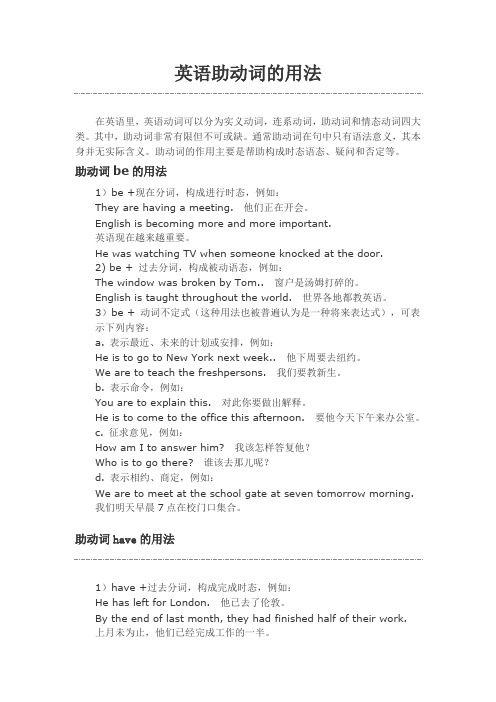
英语助动词的用法在英语里,英语动词可以分为实义动词,连系动词,助动词和情态动词四大类。
其中,助动词非常有限但不可或缺。
通常助动词在句中只有语法意义,其本身并无实际含义。
助动词的作用主要是帮助构成时态语态、疑问和否定等。
助动词be的用法1)be +现在分词,构成进行时态,例如:They are having a meeting.他们正在开会。
English is becoming more and more important.英语现在越来越重要。
He was watching TV when someone knocked at the door.2) be + 过去分词,构成被动语态,例如:The window was broken by Tom..窗户是汤姆打碎的。
English is taught throughout the world.世界各地都教英语。
3)be + 动词不定式(这种用法也被普遍认为是一种将来表达式),可表示下列内容:a. 表示最近、未来的计划或安排,例如:He is to go to New York next week..他下周要去纽约。
We are to teach the freshpersons.我们要教新生。
b. 表示命令,例如:You are to explain this.对此你要做出解释。
He is to come to the office this afternoon.要他今天下午来办公室。
c. 征求意见,例如:How am I to answer him?我该怎样答复他?Who is to go there?谁该去那儿呢?d. 表示相约、商定,例如:We are to meet at the school gate at seven tomorrow morning.我们明天早晨7点在校门口集合。
助动词have的用法1)have +过去分词,构成完成时态,例如:He has left for London.他已去了伦敦。
助动词 用法大全

助动词用法大全一、助动词的概念和分类助动词,指在句中陪衬实义动词,协助说明其时态、语态、情态、语气等语法功能的动词。
助动词一般前置于实义动词之前,构成动词的时态、语态、语气、情态等形式。
根据其用法和功能,可以分为情态助动词和非情态助动词两大类。
二、情态助动词的用法1. can/coulda. 能力:表示某人有能力实现某一行为或承担某一活动的能力。
b. 请求:表示请求、允许或提出建议。
c. 意愿:表示愿意或不愿意做某事。
2. may/mighta. 可能性:表示某物或某事有可能发生,但不一定发生。
b. 允许:表示请求或请求对方允许某事发生。
c. 客气:表示礼貌,提出请求或礼貌的推测。
3. musta. 必须:表示某事或某物必须发生,没有选择或逃避的余地。
b. 推测:表示推测或肯定的断定。
c. 意志:表示命令、请求或决定。
4. shall/shoulda. 将来时:表示将来某件事情会发生。
b. 应该:表示义务或建议。
c. 询问:用于征求对方意见或建议。
5. will/woulda. 将来时:表示将来某种情况或某件事情将要发生。
b. 意愿:表示意愿或心愿。
c. 习惯:表示过去的习惯或经常性的动作。
6. ought toa. 应该:表达义务、责任、责任感等情感。
b. 建议:表示建议或劝告。
c. 期望:常用于表达希望或期待的意愿。
三、非情态助动词的用法1. bea. 系动词:用于连接主语和表语,构成系表结构。
b. 进行时:与现在分词搭配表示主语正在进行某项活动。
c. 被动语态:与过去分词搭配表示主语受到动作的影响。
2. doa. 做动词:用于构成一般疑问句、否定式和强调句。
b. 强调:用于强调句中的动词。
3. havea. 拥有:表达主语拥有某种事物或特点。
b. 完成时:与过去分词搭配表示过去动作的完成。
4. willa. 未来时:用于表示将来发生的动作或事件。
b. 意愿:表示主语的意愿或态度。
5. cana. 能力:表示主语有能力完成某项动作。
助动词 用法大全
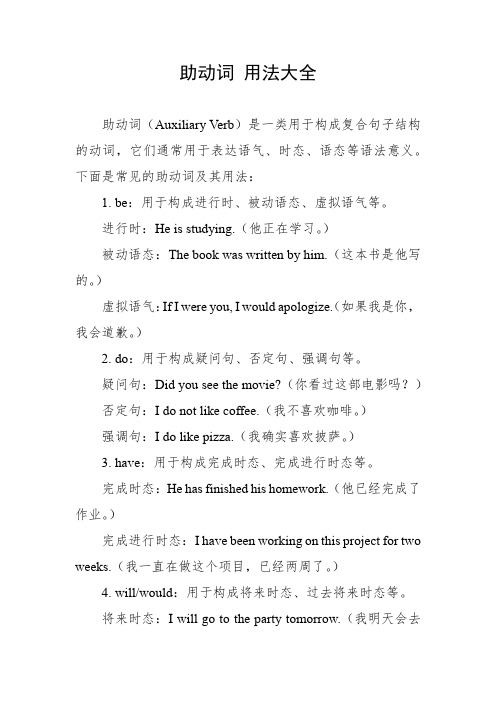
助动词用法大全助动词(Auxiliary Verb)是一类用于构成复合句子结构的动词,它们通常用于表达语气、时态、语态等语法意义。
下面是常见的助动词及其用法:1. be:用于构成进行时、被动语态、虚拟语气等。
进行时:He is studying.(他正在学习。
)被动语态:The book was written by him.(这本书是他写的。
)虚拟语气:If I were you, I would apologize.(如果我是你,我会道歉。
)2. do:用于构成疑问句、否定句、强调句等。
疑问句:Did you see the movie?(你看过这部电影吗?)否定句:I do not like coffee.(我不喜欢咖啡。
)强调句:I do like pizza.(我确实喜欢披萨。
)3. have:用于构成完成时态、完成进行时态等。
完成时态:He has finished his homework.(他已经完成了作业。
)完成进行时态:I have been working on this project for two weeks.(我一直在做这个项目,已经两周了。
)4. will/would:用于构成将来时态、过去将来时态等。
将来时态:I will go to the party tomorrow.(我明天会去参加聚会。
)过去将来时态:I would have gone to the party if I had been invited.(如果我被邀请,我本来会去参加聚会的。
)5. can/could:用于构成能力、请求、猜测等。
能力:I can swim.(我会游泳。
)请求:Could you help me with this?(你能帮我这个吗?)猜测:She might be coming late.(她可能会来晚。
)6. should/would:用于构成建议、假设等。
建议:You should take a break.(你应该休息一下。
助动词有哪些怎么用
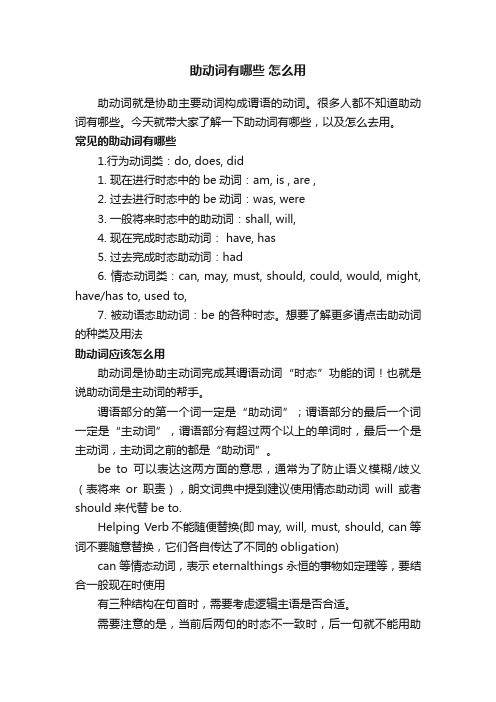
助动词有哪些怎么用助动词就是协助主要动词构成谓语的动词。
很多人都不知道助动词有哪些。
今天就带大家了解一下助动词有哪些,以及怎么去用。
常见的助动词有哪些1.行为动词类:do, does, did1. 现在进行时态中的be动词:am, is , are ,2. 过去进行时态中的be动词:was, were3. 一般将来时态中的助动词:shall, will,4. 现在完成时态助动词: have, has5. 过去完成时态助动词:had6. 情态动词类:can, may, must, should, could, would, might, have/has to, used to,7. 被动语态助动词:be 的各种时态。
想要了解更多请点击助动词的种类及用法助动词应该怎么用助动词是协助主动词完成其谓语动词“时态”功能的词!也就是说助动词是主动词的帮手。
谓语部分的第一个词一定是“助动词”;谓语部分的最后一个词一定是“主动词”,谓语部分有超过两个以上的单词时,最后一个是主动词,主动词之前的都是“助动词”。
be to可以表达这两方面的意思,通常为了防止语义模糊/歧义(表将来or职责),朗文词典中提到建议使用情态助动词will或者should来代替be to.Helping Verb不能随便替换(即may, will, must, should, can等词不要随意替换,它们各自传达了不同的obligation)can等情态动词,表示eternalthings永恒的事物如定理等,要结合一般现在时使用有三种结构在句首时,需要考虑逻辑主语是否合适。
需要注意的是,当前后两句的时态不一致时,后一句就不能用助动词指代。
还有当前后两句的时态不需要一致时,后一句的助动词需要跟随句意,而非生硬照搬前一句的助动词。
还有助动词用的都是肯定语气,即使全句的句义是否定的。
常用的助动词用法
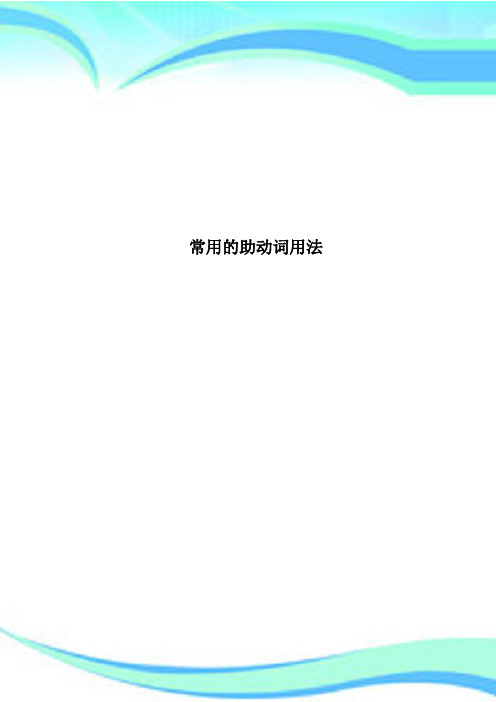
常用的助动词用法————————————————————————————————作者:————————————————————————————————日期:协助主要动词构成谓语的词叫助动词(Auxiliary Verb)。
被协助的动词称作主要动词(Main Verb)。
助动词用来构成时态和语态。
助动词具有语法意义,但没有词汇意义,不可单独作谓语。
它没有对应的汉译,例如:He doesn't like English. 他不喜欢英语。
(does是助动词,无词义;like是主要动词,有词义)定义最常用的助动词有:be, have, has, do, does, shall, did, will, should, would等,助动词可以协助主要动词构成时态或者语态,也可构成疑问句和否定句,构成否定句时与否定副词not连用。
1.半助动词在功能上介乎主动词和助动词之间的一类结构,称为半助动词。
常见的半助动词有be about to, be due to, be going to, be likely to, be meant to, be obliged to, be supposed to, be willing to, have to, seem to, be unable to, be unwilling to等。
......2.情态助动词情态助动词1.情态助动词包括will(would), shall(should), can(could), may(might),must, need, dare, ought to, used to, had better后接原形不定词。
2.情态助动词不受主语的人称和数的限制。
3.两个情态助动词不能连用。
中文:他将能够及时完成此事。
(误)He will can finish it i...... 3.基本助动词基本助动词基本助动词只有三个:be, do, have, 它们没有词汇意义,只有语法作用,如协助构成进行体,完成体,被动态,否定句,疑问句等。
助动词和情态动词的用法总结

助动词和情态动词的用法总结
助动词的用法:
1.助动词可用来构成时态和语态。
例如:
- be动词(am, is, are, was, were, been, being)用来构成进行时和被动语态。
- have动词(have, has, had)用来构成完成时。
- do动词(do, does, did)用来构成否定句、疑问句和强调句。
2.助动词还可以用来构成虚拟语气、条件句和祈使句。
例如:
- 可以使用助动词“would”来表示虚拟语气,表示假设、愿望或建议。
- 可以使用助动词“should”和“could”来表示条件句中的假设情况。
- 在祈使句中,使用助动词“do”来加强语气,表示命令、请求或建议。
情态动词的用法:
1.情态动词可以用来表示能力、可能性、许可、意愿、推测、必要性等。
例如:
- can表示能力或许可。
- may表示可能性或许可。
- must表示必要性或推测。
2.情态动词没有人称和数的变化,后面接动词原形。
例如:
- I can swim.(我会游泳。
)
- You must finish your homework.(你必须完成作业。
3.情态动词可以用来构成否定句和疑问句。
例如:
- They can't go to the party.(他们不能去参加派对。
)
- Can you help me?(你能帮我吗?)
总体来说,助动词和情态动词都是在句子中用来辅助或表达其他动词的特殊词语,它们的使用方式和意义有所不同,具体用法需根据具体上下文进行判断。
助动词的用法

助动词
助动词用于表示人称、时态和语态 1) be, have, do 2) shall/should, will/wouldBiblioteka 助动词—时态和语态的承载者
1
1. be
1) 构成进行时态:be + v-ing A. 当be为am/is/are时,构成现在进行时。 B. 当be为was/were时,构成过去进行时。 2) 构成完成进行时态:have + been + v-ing A. 当have为have/has时,构成现在完成进行时。 B. 当have为had时,构成过去完成进行时。 3) 构成被动语态 be + p.p.
助动词—时态和语态的承载者
4
6. shall 表示将来,用于第一人称。 7. should 1) 表示过去将来,用于第一人称。 2)表示婉转请求,用于第一人称:I should like to phone my lawyer. 3) 用于某些句型的谓语中。 A. 宾语从句:He suggested that we should do it at once. B. 主语从句:It is better that he should hear from you. 4) 用于虚拟语气。 If you should be passing, do come and see us.
助动词—时态和语态的承载者
2
2. have 1) 构成完成时态:have + done A. 当have为have/has时,构成现 在完成时。 B. 当have为had时,构成过去完成时。 2) 构成完成进行时态:have + been + v-ing 3. do 1) 构成疑问/否定。 2) 用于强调动词:I did do it yesterday. 3) 用于代替上文中刚提及的动作,以避免重复:He lives here but I don’t.
助动词的基本功用
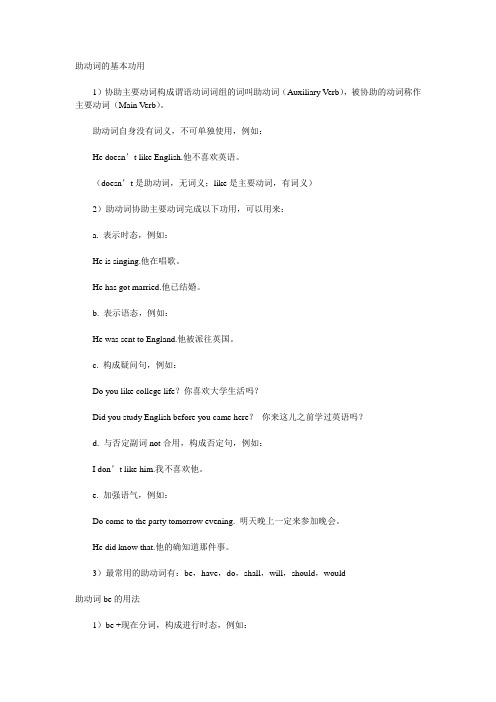
助动词的基本功用1)协助主要动词构成谓语动词词组的词叫助动词(Auxiliary Verb),被协助的动词称作主要动词(Main Verb)。
助动词自身没有词义,不可单独使用,例如:He doesn’t like English.他不喜欢英语。
(doesn’t是助动词,无词义;like是主要动词,有词义)2)助动词协助主要动词完成以下功用,可以用来:a. 表示时态,例如:He is singing.他在唱歌。
He has got married.他已结婚。
b. 表示语态,例如:He was sent to England.他被派往英国。
c. 构成疑问句,例如:Do you like college life?你喜欢大学生活吗?Did you study English before you came here?你来这儿之前学过英语吗?d. 与否定副词not合用,构成否定句,例如:I don’t like him.我不喜欢他。
e. 加强语气,例如:Do come to the party tomorrow evening. 明天晚上一定来参加晚会。
He did know that.他的确知道那件事。
3)最常用的助动词有:be,have,do,shall,will,should,would助动词be的用法1)be +现在分词,构成进行时态,例如:They are having a meeting.他们正在开会。
English is becoming more and more important. 英语现在越来越重要。
2)be + 过去分词,构成被动语态,例如:The window was broken by Tom……窗户是汤姆打碎的。
English is taught throughout the world.世界各地都教英语。
3)be + 动词不定式,可表示下列内容:a. 表示最近、未来的计划或安排,例如:He is to go to New York next week……他下周要去纽约。
助动词be、do、have的助动词用法

助动词be、do、have的助动词用法关于英语的助动词,大家知道的有哪些吗?接下来,小编给大家准备了助动词be、do、have的助动词用法,欢迎大家参考与借鉴。
助动词be、do、have的助动词用法be的助动词用法be作助动词用的形式如下:①am, is, are, was, were②助动词+be:shall be, will be, can be, etc.③have/has/had + been(完成时)④am, is, …being(进行时)(1)表达进行时态句型 be + V-ing…(进行时态)例:What are you reading?(你正在阅读什么?)I am reading a magazine.(我正在阅读杂志。
)例:He will be taking a walk in the park at this time tomorrow morning.(明天早晨此时他将会正在公园散步。
)例:She has been teaching1 English in our school for years.(她已在我们学校教英语许多年了。
)解说:第一例句是表达现在进行时,第二例句是将来进行时,第三例句是现在完成进行时。
(2)表达被动语态句型be +p.p. …(被动语态)例:English is spoken in both Canada and the United States.(加拿大和美国都讲英语。
)例:Those keys were found in your drawer.(那些钥匙是在你的抽屉里找到的。
)例:It can be done much faster in this way.(这件工作用这个方法可以更加快速地做好。
)have的助动词用法(1)表达完成时态句型have (has, had1) +p.p. …句型can (could2), …have + p.p.例:He can’t have said3 such4 a foolish5 word.(他不像是会说了这样傻的话。
英语中助动词有哪些 有什么用法
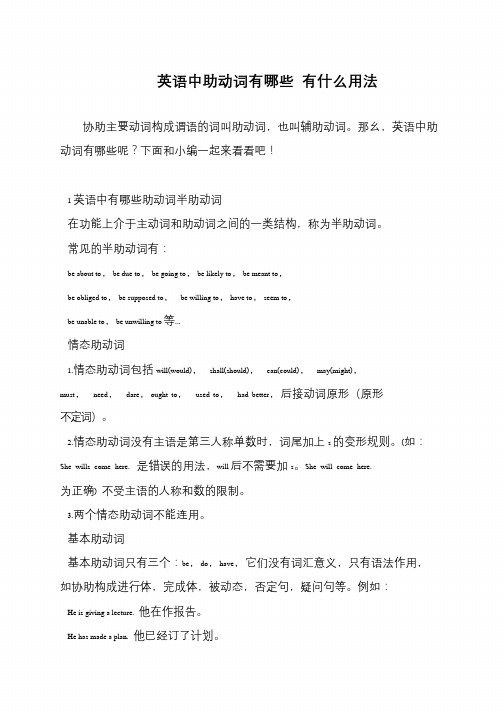
英语中助动词有哪些有什么用法
协助主要动词构成谓语的词叫助动词,也叫辅助动词。
那幺,英语中助动词有哪些呢?下面和小编一起来看看吧!
1 英语中有哪些助动词半助动词
在功能上介于主动词和助动词之间的一类结构,称为半助动词。
常见的半助动词有:
be about to,be due to,be going to,be likely to,be meant to,
be obliged to,be supposed to,be willing to,have to,seem to,
be unable to,be unwilling to 等...
情态助动词
1.情态助动词包括will(would),shall(should),can(could),may(might),
must,need,dare,ought to,used to,had better,后接动词原形(原形
不定词)。
2.情态助动词没有主语是第三人称单数时,词尾加上s 的变形规则。
(如:She wills come here. 是错误的用法,will 后不需要加s。
She will come here.
为正确) 不受主语的人称和数的限制。
3.两个情态助动词不能连用。
基本助动词
基本助动词只有三个:be,do,have,它们没有词汇意义,只有语法作用,如协助构成进行体,完成体,被动态,否定句,疑问句等。
例如:
He is giving a lecture. 他在作报告。
He has made a plan. 他已经订了计划。
助动词 用法大全

助动词用法大全助动词是一类在句中不具有实际意义,主要用来表示动作或状态的程度、方式、时间、情态等语法意义的词。
助动词在英语中起着非常重要的作用,它们能够用来表达各种语态、时态、情态以及虚拟语气等。
在这篇文章中,我们将深入探讨助动词的用法,包括各种时态、句型和使用技巧等。
一、助动词的定义和分类1. 助动词的定义助动词是指在构成句子时用来帮助其他动词构成时态、语态、情态或表示意愿等语法形式的动词。
助动词一般不单独充当谓语,必须与其他实义动词连用构成谓语。
2. 助动词的分类助动词可分为情态动词和非情态助动词两大类。
情态动词包括can, could, may, might, must, shall, should, will, would等,而非情态助动词包括be, do, have等。
二、助动词的时态和句型1. 助动词在进行时态表达中的作用BE动词是进行时态中的助动词,用于帮助主要动词构成进行时态。
“She is reading a book.”中的is就是助动词,帮助构成进行时态。
2. 助动词在完成时态表达中的作用HAVE动词是完成时态中的助动词,用于帮助主要动词构成完成时态。
“He has finished his homework.”中的has就是助动词,帮助构成完成时态。
3. 助动词在被动语态表达中的作用BE动词是被动语态中的助动词,用于帮助主要动词构成被动语态。
“The book is written by him.”中的is就是助动词,帮助构成被动语态。
4. 助动词在情态语气表达中的作用情态动词用于表达说话人对某种行为或状态的看法、推测、愿望等情态。
“You should study hard.”中的should就是情态动词,表达了说话人的建议或劝告。
5. 助动词在虚拟语气表达中的作用助动词也常用于表达虚拟语气,表示与事实相反或与现实情况不符的假设。
“If I were you, I would study harder.”中的were和would就是助动词,表示与现实情况不符的假设。
助动词知识点初中总结

一、助动词的种类英语中常见的助动词有be, have, do, can, could, may, might, must, shall, should, will, would 等。
这些助动词有时用作情态动词,有时用作实义动词。
1. 情态动词:可以表示说话人对事件发生可能性、必然性、愿望、承诺等态度。
2. 实义动词:具有实际的动作意义。
二、助动词的用法1. 表示时态助动词在构成英语时态时发挥着关键的作用。
例如,在现在完成时的句子中,主要动词前必须使用助动词have。
在进行时的句子中,必须使用助动词be。
在一般过去时的句子中,必须使用助动词did等。
2. 表示语气助动词还可以表示不同的语气,如愿望、条件、命令等。
例如,在表达愿望时可以使用助动词would;在表示条件时可以使用助动词must;在表达命令时可以使用助动词shall等。
3. 表示否定和疑问助动词还可以帮助构成否定句和疑问句。
在否定句中,助动词与not连用;在疑问句中,助动词通常出现在句子的最前面。
三、助动词在句子中的位置助动词在句子中的位置通常是在谓语动词之前。
在构成否定句和疑问句时,助动词的位置会发生调整。
在一般陈述句中,助动词位于主要动词之前,而在否定句和疑问句中,助动词会移动到句首位置。
四、助动词在固定搭配中的应用助动词在英语中还有很多固定搭配。
例如,can't help doing sth.表示情不自禁做某事;have to do sth.表示不得不做某事等。
五、助动词的练习技巧1. 在练习助动词时,可以通过多做句子转换、口语练习等方式加深对助动词的理解和运用。
2. 注意语境,学会灵活应用不同的助动词,避免死记硬背,提高语言表达的灵活性和准确性。
1. 助动词分辨错误:有些助动词在用法上非常相似,容易引起混淆,如can和may,在表示许可时很容易混淆。
2. 助动词位置错误:助动词的位置在句子中要正确,否则会影响句子的语法和意义。
助动词的用法
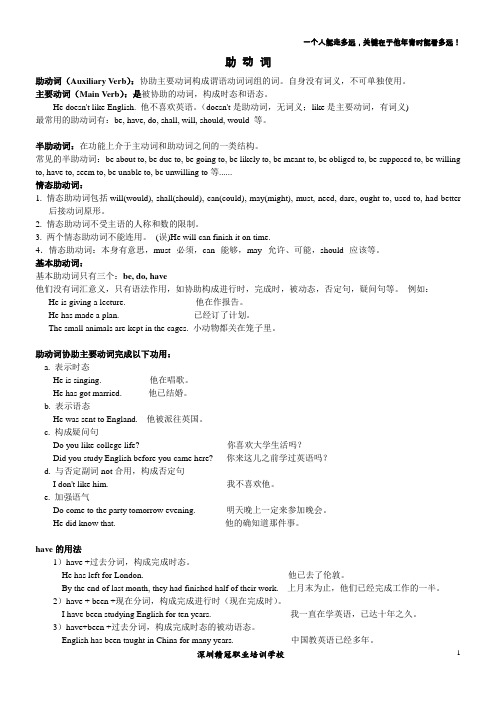
助动词助动词(Auxiliary Verb):协助主要动词构成谓语动词词组的词。
自身没有词义,不可单独使用。
主要动词(Main Verb):是被协助的动词,构成时态和语态。
He doesn't like English. 他不喜欢英语。
(doesn't是助动词,无词义;like是主要动词,有词义)最常用的助动词有:be, have, do, shall, will, should, would 等。
半助动词:在功能上介于主动词和助动词之间的一类结构。
常见的半助动词:be about to, be due to, be going to, be likely to, be meant to, be obliged to, be supposed to, be willing to, have to, seem to, be unable to, be unwilling to等......情态助动词:1. 情态助动词包括will(would), shall(should), can(could), may(might), must, need, dare, ought to, used to, had better后接动词原形。
2. 情态助动词不受主语的人称和数的限制。
3. 两个情态助动词不能连用。
(误)He will can finish it on time.4.情态助动词:本身有意思,must--必须,can--能够,may--允许、可能,should--应该等。
基本助动词:基本助动词只有三个:be, do, have他们没有词汇意义,只有语法作用,如协助构成进行时,完成时,被动态,否定句,疑问句等。
例如:He is giving a lecture. 他在作报告。
He has made a plan. 已经订了计划。
The small animals are kept in the cages. 小动物都关在笼子里。
助动词 用法大全
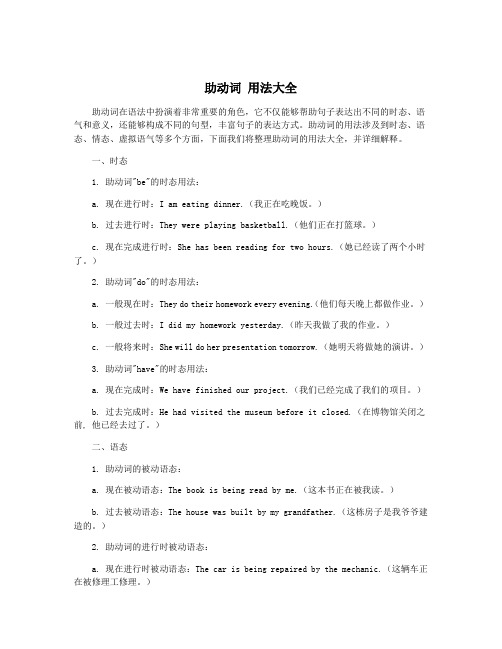
助动词用法大全助动词在语法中扮演着非常重要的角色,它不仅能够帮助句子表达出不同的时态、语气和意义,还能够构成不同的句型,丰富句子的表达方式。
助动词的用法涉及到时态、语态、情态、虚拟语气等多个方面,下面我们将整理助动词的用法大全,并详细解释。
一、时态1. 助动词"be"的时态用法:a. 现在进行时:I am eating dinner.(我正在吃晚饭。
)b. 过去进行时:They were playing basketball.(他们正在打篮球。
)c. 现在完成进行时:She has been reading for two hours.(她已经读了两个小时了。
)2. 助动词"do"的时态用法:a. 一般现在时:They do their homework every evening.(他们每天晚上都做作业。
)b. 一般过去时:I did my homework yesterday.(昨天我做了我的作业。
)c. 一般将来时:She will do her presentation tomorrow.(她明天将做她的演讲。
)3. 助动词"have"的时态用法:a. 现在完成时:We have finished our project.(我们已经完成了我们的项目。
)b. 过去完成时:He had visited the museum before it closed.(在博物馆关闭之前, 他已经去过了。
)二、语态1. 助动词的被动语态:a. 现在被动语态:The book is being read by me.(这本书正在被我读。
)b. 过去被动语态:The house was built by my grandfather.(这栋房子是我爷爷建造的。
)2. 助动词的进行时被动语态:a. 现在进行时被动语态:The car is being repaired by the mechanic.(这辆车正在被修理工修理。
助动词的用法
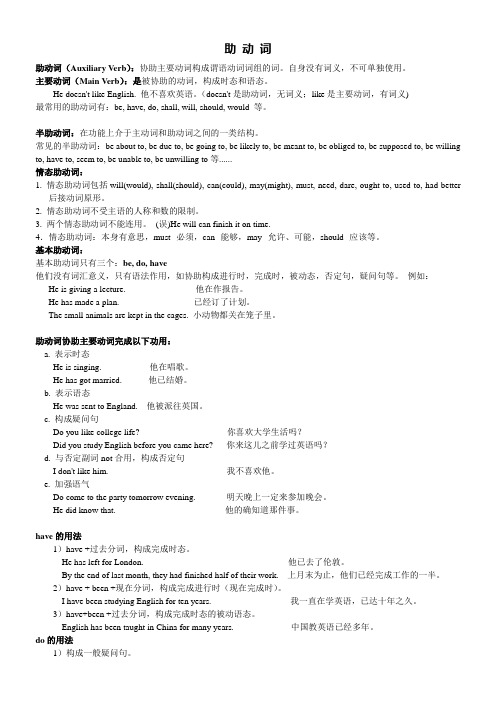
助动词助动词(Auxiliary Verb):协助主要动词构成谓语动词词组的词。
自身没有词义,不可单独使用。
主要动词(Main Verb):是被协助的动词,构成时态和语态。
He doesn't like English. 他不喜欢英语。
(doesn't是助动词,无词义;like是主要动词,有词义)最常用的助动词有:be, have, do, shall, will, should, would 等。
半助动词:在功能上介于主动词和助动词之间的一类结构。
常见的半助动词:be about to, be due to, be going to, be likely to, be meant to, be obliged to, be supposed to, be willing to, have to, seem to, be unable to, be unwilling to等......情态助动词:1. 情态助动词包括will(would), shall(should), can(could), may(might), must, need, dare, ought to, used to, had better后接动词原形。
2. 情态助动词不受主语的人称和数的限制。
3. 两个情态助动词不能连用。
(误)He will can finish it on time.4.情态助动词:本身有意思,must--必须,can--能够,may--允许、可能,should--应该等。
基本助动词:基本助动词只有三个:be, do, have他们没有词汇意义,只有语法作用,如协助构成进行时,完成时,被动态,否定句,疑问句等。
例如:He is giving a lecture. 他在作报告。
He has made a plan. 已经订了计划。
The small animals are kept in the cages. 小动物都关在笼子里。
助动词的用法.

助动词的基本功用1)协助主要动词构成谓语动词词组的词叫助动词(Auxiliary Verb),被协助的动词称作主要动词(Main Verb)。
助动词自身没有词义,不可单独使用,例如:He doesn’t like English.他不喜欢英语。
(doesn’t是助动词,无词义;like是主要动词,有词义)2)助动词协助主要动词完成以下功用,可以用来:a. 表示时态,例如:He is singing.他在唱歌。
He has got married.他已结婚。
b. 表示语态,例如:He was sent to England.他被派往英国。
c. 构成疑问句,例如:Do you like college life?你喜欢大学生活吗?Did you study English before you came here?你来这儿之前学过英语吗?d. 与否定副词not合用,构成否定句,例如:I don’t like him.我不喜欢他。
e. 加强语气,例如:Do come to the party tomorrow evening. 明天晚上一定来参加晚会。
He did know that.他的确知道那件事。
3)最常用的助动词有:be,have,do,shall,will,should,would助动词be的用法1)be +现在分词,构成进行时态,例如:They are having a meeting.他们正在开会。
English is becoming more and more important. 英语现在越来越重要。
2)be + 过去分词,构成被动语态,例如:The window was broken by Tom……窗户是汤姆打碎的。
English is taught throughout the world.世界各地都教英语。
3)be + 动词不定式,可表示下列内容:a. 表示最近、未来的计划或安排,例如:He is to go to New York next week……他下周要去纽约。
助动词的用法口诀6

助动词的用法口诀6在英语学习中,助动词是一个重要的语法点,掌握助动词的用法对于正确表达和理解句子的意思至关重要。
下面就为大家介绍助动词的用法口诀 6,帮助大家轻松掌握助动词的用法。
口诀一:“be 动词,表状态”be 动词(am/is/are/was/were)主要用来表示主语的状态。
比如:“I am a student”(我是一名学生。
)这里的“am”就表示“我”的身份状态。
“She is beautiful”(她很漂亮。
)“is”表明了“她”的特征状态。
当主语是复数或者第一人称复数时,我们用“are”。
例如:“We are friends”(我们是朋友。
)过去时态中,则根据主语的不同,分别使用“was”(主语是单数)和“were”(主语是复数)。
如:“He was at home yesterday”(他昨天在家。
)“They were happy last week”(他们上周很开心。
)口诀二:“do/does 来帮忙,一般现在常登场”“do”和“does”用于一般现在时,当句子中的主语是第三人称单数时,用“does”,其他人称用“do”。
它们主要用于构成否定句和疑问句。
比如:“I don't like coffee”(我不喜欢咖啡。
)“He doesn't play football”(他不踢足球。
)在疑问句中,“Do you have a pen?”(你有一支笔吗?)“Does she speak English?”(她讲英语吗?)口诀三:“have/has 表拥有,完成时态要记清”“have”和“has”表示“拥有”的意思,同时也用于现在完成时态。
当主语是第三人称单数时,用“has”,其他人称用“have”。
例如:“I have a book”(我有一本书。
)“She has a new dress”(她有一条新裙子。
)在现在完成时态中,“I have finished my homework”(我已经完成了作业。
助动词表示强调的用法

助动词在英语学习当中作了解,不需要重点把握,但是助动词也是很好理解的,希望回答能够帮到你。
1.助动词:Be助动词不能作述语动词,要与本动词一起构成动词片语,表示时态、语态等。
1. BE作为本动词表示状态或客观存在等意思。
Your house is bigger and nicer than mine.你的房子比我的又大又好。
2. BE+不定词连用,表示约定、义务、命令等未来的动作或状态。
I am to go abroad on business tomorrow.明天我要去xx出公差。
表示未来的安排。
The meeting is to be held as scheduled.会议将按原计划召开。
表示计划好的安排。
You are not to bark at my friend.你不许对我的朋友叫。
表示命令或要求。
3. BE+现在分词构成各种进行时态。
Who are you talking to?你在和谁说话?I am talking to my dog.我在和我的狗说话。
4. BE+过去分词构成被动语态。
That means I will be promoted as scheduled.这就意味着我将要按原计划得到提升。
2. dare和used to作为情态助动词的dare一般只能用于疑问句或否定句中,dare+原形动词表示敢。
I dare not say it is ugly.我不敢说它丑。
How dare you say so?你怎么敢这么说?dare也可以作本动词,用于肯定句,后面要接带to的不定词;主词若是第三人称单数,简单现在式时,dare要变为dares。
You, you dare to talk to me like this!你、你竟敢这样和我讲话!used to+原形动词表示过去的习惯或状态,而现在已经不存在了。
You're not what you used to be.你不是以前的你了。
- 1、下载文档前请自行甄别文档内容的完整性,平台不提供额外的编辑、内容补充、找答案等附加服务。
- 2、"仅部分预览"的文档,不可在线预览部分如存在完整性等问题,可反馈申请退款(可完整预览的文档不适用该条件!)。
- 3、如文档侵犯您的权益,请联系客服反馈,我们会尽快为您处理(人工客服工作时间:9:00-18:30)。
助动词的用法大全
助动词的形式与作用
1)英语常用的助动词(auxiliary verb)有shall,will,should,would,be,have,do等。
助动词一般无词义,不能单独作谓语动词。
助动词在句中的作用,在于帮助构成各种时态、语态、语气、否定和疑问结构等。
如:China has entered a great new era. 中国已进入了一个伟大的新时期。
(帮助构成完成时态)
Some boys are playing on the grass. 一些男孩正在草地上玩。
(帮助构成进行时态)
Mother is written by Gorky. 《母亲》是高尔基写的。
(帮助构成被动语态)
We Shall have the football match if it does not rain.如果不下雨,我们就赛足球。
(帮助构成将来时态和否定结构)
Do you see my point? 你明白我的意思吗?(帮助构成疑问结构)
[注]在否定结构中,not须放在助动词后面。
2)助动词加not一般都有简略式,用于口语中。
如:
is not-isn't would not--wouldn't
are not--aren't [B:nt] have not--haven't
was not -- wasn't has not--hasn't
were not-- weren't [wE:nt] had not--hadn't
shall not--shan't [FB:nt] do not--don't [dEunt]
will not--won't [wEunt] does not--doesn't
should not--shouldn't did not--didn't
be
助动词
be的形式变化和动词be。
be作为助动词的用法有下列几种:
1)be后跟动词的现在分词可以构成各种进行时态。
如:
The driver is cleaning the car.司机在擦车。
Yesterday afternoon we were discussing a new plan.昨天下午我们在讨论一个新的计划。
Women in our country are playing an important part in socialist construction.我国妇女在社会主义建设中正起着重要的作用。
2) be后跟动词的过去分词可以构成被动语态。
如:
A lot of consumer goods are made of nylon.许多消费品都是尼龙作的。
The Flower Show is usually held here in October. 花展通常于10月在此举行。
The cinema will be closed for repair from March 3rd.影院自三月三日起修理内部停止营业。
3)be加动词不定式有下列各种用法:
a)表示未来的安排或计划。
如:
The delegation is to leave for Shanghai tomorrow.代表团定于明天去上海。
I'm to be home before midnight.我午夜前一定回来。
b)表示必要或命令或问对方的意志。
如:
You're to hand in your exercises tomorrow.你们明天要交练习。
Where am I to put these tools? 这些工具应该放在什么地方?
What is to be done?怎么办?
c)表示"可能",与can或may相仿。
如:
I am not sure whether he is to turn up tonight.我不能断定他今晚是否能来。
My key is nowhere to be found.我哪儿也找不着我的钥匙。
d) be + about + 动词不定式则表计划即将,如:
The meeting is about to begin.会议即将开始。
have
的过去式是had。
Have (had)作为助动词和过去分词一起,构成各种完成时态。
如:
I have known Mr. Smith for four years.我认识史密斯先生已经四年了。
He has not made up his mind yet.他还没有决定呢。
A woman came in with a baby,who had just swallowed a safety pin.一个妇女带进来一个刚吞进一个别针的婴儿。
[注] have的简略式是've,has的简略式是's,had的简略式是'd,如
I've,you've,he's,I'd,we'd,he'd,they'd等。
do
的过去式是did。
do (did)作为助动词,有下列一些用法:
1)构成现在一般时和过去一般时的疑问句和否定句。
如:
Do you know each other? 你们两人认识吗?
How do you find the climate here? 你觉得这里的气候怎么样?
She did not go to hospital after breakfast She went to work as usual.早饭后她没有去医院,她照常上班去了。
2)构成否定的祈使句。
如:
Don't be so careless.不要那么粗枝大叶。
Do not hesitate to come when you need help.有困难只管来。
3)加强陈述句和祈使句的语气。
如:
I do think he is right.我确实认为他是对的。
Do come often.一定常来呀。
Do ask,if you have any questions.如果有问题,务必提出。
4)用于倒装句中。
如:
Only then did I understand the importance of science.只是到了那时,我才了解到科学的重要性。
Never did I expect to see him there.我从未想到会在那里看到他。
5)还可用来代替主要动词,以避免重复。
较常用在简略答语中。
如:
Does he also study geography?他也学地理吗? ――Yes,he does.是的,他也学地理。
Did it snow a lot last week? ――Yes,it did。
上星期雪下得多吗? --是的,下得很多。
He works even harder than you do. 他比你还要用功。
[注] 上面最后一句中的do应唤作替代词,只是为了初学者的方便而放在助动词项下。
shall和Will
助动词
shall本身没有词义,只用在第一人称的将来时态中(现多为will所代替)。
在将来一般时中,shall后接动词原形。
如:
I shall think it over.我要好好考虑一下。
Don't worry. We shall tell you all about it.你别担心。
我们都会告诉你的。
助动词
will本身没有词义,只用在第二、三人称的将来时态中。
will在将来一般时中后接动词原形。
如:
He will be twenty-five years old next month.他下个月将是二十五岁。
You will have an examination in English tomorrow.你们明天有英语考试。
The weather forecast says that there'll be heavy rain tomorrow.天气预报明天有大雨。
should和would
助动词
should是shall的过去式,它本身没有词义,用于第一人称的过去将来时态中(现多用would)。
should在过去将来一般时中后接动词原形。
如:We were told that we should sight the Treasure lsland that night. 我们被告知那天夜里我们就要看见宝岛了。
助动词
would是will的过去式,它本身没有词义,用于第二、三人称的过去将来时态中。
would在过去将来一般时中后接动词原形。
如:
He said that he would always remember that day.他说他将永远记住那一天。
